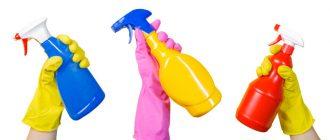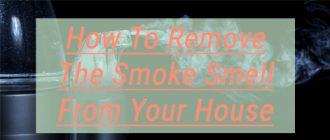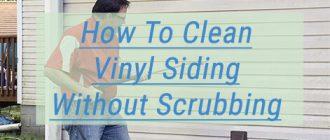You’re painting your walls a brand new color to refresh your space, and it happens. Paint drips onto your laminate flooring. You notice right away and wipe up the spots with a damp cloth. Problem solved.
A few days pass, and you notice more paint spots. You can’t believe you missed them when you were painting the first time. They’re dry, so you can’t just wipe them up. You wish you’d invested in that drop cloth after all. You begin to sweat, wondering if you’ll have to replace those boards. Maybe you’ll have to replace the whole floor.
Calm down.

Before you go worst case scenario, try a few of our suggestions to remove that paint and get on with your life. Let’s look at a few different ways to do it.
Paint and Laminate: What You Need To Know
It can take paint several hours to dry completely, especially if it’s in a blob. If you can’t use a drop cloth of some kind, carefully inspect your flooring once you’re finished painting to find any spills before they dry. Wipe them up with a warm, damp cloth.
Some people will suggest that you use paint thinner or chemical spirits to remove dried paint quickly, but we hate this idea. That stuff smells and is seriously caustic. You could remove the paint and end up taking the laminate surface and your nose hairs along with it.
Instead, try a few of our less caustic solutions.
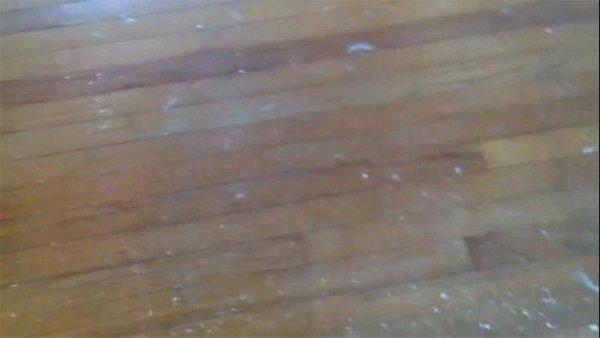
Before You Start
If you’re sure the paint is completely dry, vacuum around the area to remove any dirt and debris. You’ll be gently scrubbing the paint stain, and you don’t want to scratch the surface of your laminate flooring because that can encourage small amounts of paint to lodge into the scratches. It’s a lot harder to remove if that’s the case.
Be sure you test any cleaning solution on an inconspicuous part of your flooring before you start.
It shouldn’t remove any of the finish or coloring of your laminate. Test the cleaning solution and then come back after 24 hours to make sure no further damage has happened.
Basic Cleaning – Homemade Solution
Let’s start with the basics.
You’ll need:
- vinegar
- water
- rubbing alcohol
- dish soap
- cloth or mop
Here you can choose the best mop for laminate floors
- Mix equal parts vinegar, water, and rubbing alcohol. Add a few drops of the dish soap.
- Pour a small amount onto the paint and gently rub it with your rag until it begins to come up.
- Repeat the steps until the paint is completely removed.
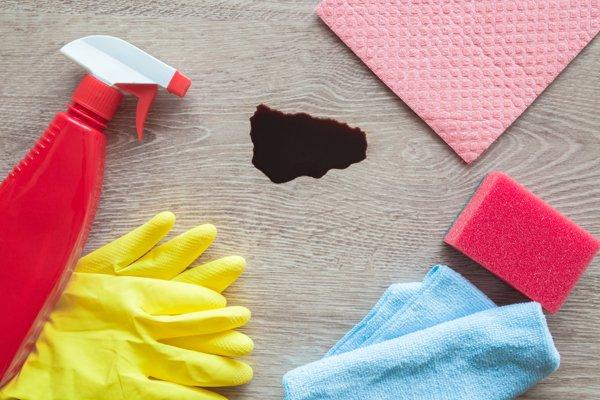
Stubborn Paint – Acetone
If your paint doesn’t come up with the homemade solution, or if the paint is in a crack and more difficult to remove, try this.
You’ll need:
- nail polish remover
- cotton ball
- Pour a small bit of nail polish remover onto the stain and allow it to sit for a few minutes. You may see the color begin to swirl a little bit.
- Use the cotton ball to dab the stain and gently lift the paint.
- Repeat the steps with new polish remover and a clean cotton ball until the color is completely removed.
Note: For paint lodged in flooring cracks, you may find a cotton swab more convenient for getting down into the crack to remove the color. Regardless, the loose cotton helps draw up the color.
Stubborn Paint – Window Cleaner
If you don’t have nail polish remover laying around, you may have window cleaner. The ammonia from the cleaner can also break up the pigment from the paint and help it come up.
You’ll need:
- window cleaner
- clean cloth
- Spray the cleaner onto the stain and allow it to sit for a few minutes.
- Test the area with your cloth to see if the paint begins to lift off. If it doesn’t, allow the cleaner to sit a little bit longer.
- When the color begins to lift, gently rub the spot in a circular motion to help remove the paint, alternating with wiping motions to pull it off the floor.
- Repeat the steps until the stain is gone.

After Cleaning – Rinse Thoroughly
After each of our cleaning methods, you need to come behind your stain removal and clean the floor gently with plain water. If you leave traces of any of these cleaning compounds, it can slowly eat at the finish of the floor or affect the color.
The best way to do this is with a warm, just damp cloth. Wipe the area thoroughly and allow it to dry. If you have any water drips, clean them up so that you don’t leave water spots.
Maintaining Your Floors
We really recommend that you put down a drop cloth to prevent paint spills in the first place. The cleaning techniques we mentioned above are for smaller drips, but if you get an entire paint can on your floor, they may not be able to help you recover your floor. It’s better to take some time and prevent those spills than to chance having a colossal disaster that no amount of nail polish remover can help.
Another way to prevent drips is to properly wipe your brush or roller each time you dip it. Put paint on the wall slowly and methodically to avoid slinging little droplets of paint everywhere.
If nothing else, turn to a professional who can paint your walls and manage any disasters along the way. An ounce of prevention and all.
Final Thoughts
Your floors are a huge investment. You can always repaint your walls to cover any mistakes, but making a huge mistake with your floors can have a significant impact on your home’s value. We think you should take precautions when you paint, but with little spills, catching them early is the key to getting them off your floor.
Again, inspect your floors carefully once you finish painting so you can wipe up any spills that haven’t dried yet. The longer you wait to handle paint stains, the harder it is to treat the problem. Time is your friend so handle those stains right away.
Be honest. Are you the type to painstakingly tape and lay drop cloths or do you just wing it? Tell us which camp you belong to in the comments below.

